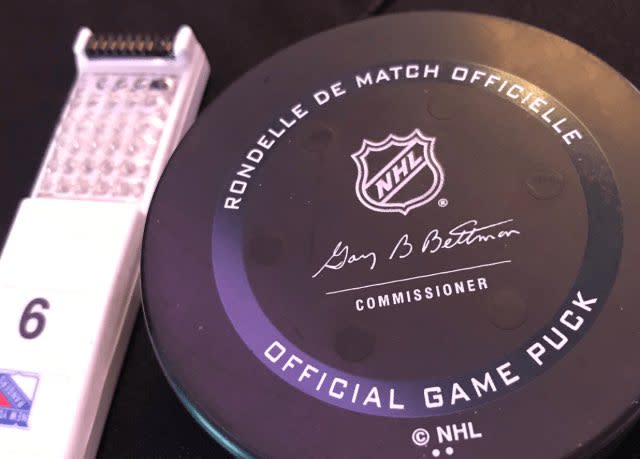Tastiest takeaways from NHL's general manager meetings
NHL general managers just wrapped up their winter meetings in Boca Raton, Florida this week, with the league finally starting to take action on a couple major issues, while another controversial system will stay in place as is.
Fresh off the David Ayres emergency goaltender saga, the EBUG was destined to be a hot topic. It certainly. was, but the league and its GMs decided that, at least for now, the system is working well enough to be left alone.
The NHL first made a change to the emergency backup goalie protocol back in 2015 when then-Panthers goalie Roberto Luongo took a puck off the head and left to go to the hospital, but was forced back into the game when backup Al Montoya was also injured. Goalie coach Robb Tallas dressed to play, and Luongo returned to the game despite a potential serious head injury. From that sequence of events, the EBUG was born.
And for now that’s how it will stay as the league decided to turn its attention to several of the game’s other pressing issues, like the much-maligned offside and review system which currently sucks, a lot.
Offsides
That whole protocol just got a little bit better, at least.
After 3 years of discussions, it appears the NHL will amend the offside rule. Skate in the air...or breaking the plane is expected to be part of the change.
— Darren Dreger (@DarrenDreger) March 3, 2020
At long last the league appears to be ready to at least somewhat overhaul the worst parts of its offside rule, with TSN’s Darren Dreger reporting that having a “skate in the air” or “breaking the plane” is expected to be part of the change.
As the offside rule currently stands, players must have their back skate on the ice and not ahead of the blue line when the puck enters the offensive zone. This potential adjustment is big in the sense that it will not only drastically cut down the number of offside reviews killing the flow of the game, but also the length of them.
It should also theoretically increase scoring as no longer will goals be disallowed because a dude’s skate blade was a victim of physics and lifted off the ice by a fraction of a dog hair.
The general managers will still need the approval of the NHL's Competition Committee and then the league's board of governors to officially push a rule change through, but that’s looking like a formality at this point.
This isn’t quite abolishing offside review altogether (which many would like to see), but it’s a start for sure.
The Cap
News on the latest salary cap numbers was quite positive as well, as the ceiling is expected to rise fairly substantially.
Teams crunched against this season’s $81.5-million salary cap— the Maple Leafs, Canucks, Capitals, Penguins and Jets to name a few— will especially benefit from the league’s projection of a salary cap between $84 and $88.2 million for next season. However, as one general manager pointed out, it’s fine to be skeptical until anything is made official.
“It’s still in generalities and ranges,’’ Winnipeg Jets GM Kevin Cheveldayoff said, per The Athletic’s Pierre LeBrun.
“I don’t think anyone is betting on it — given what’s transpired over the last couple of years where you have to guess where the final number comes in. The mechanism that sets the cap is revenue, so once all the revenues get in and then the second mechanism is the potential use of the escalator or not. So until all those decisions are made, it’s still a very light pencil mark.’’
Last offseason the ceiling was originally projected for $83 million but ended up at $81.5 million, squeezing Cheveldayoff’s Jets and several other clubs against the cap. So, being cautiously optimistic here is probably the wise play.
New Pucks
The league announced Tuesday that player- and puck-tracking will debut full-time starting on the opening night of the Stanley Cup playoffs.

It of course sounds outrageous to debut a brand new puck with sensitive tracking technology on the first night of the postseason, but the new biscuits have apparently been tested extensively and the league is fully confident that everything will be good to go by the first night in April.
The NHL has been testing the tracking pucks through a third party over the past several months. The new ones are made of the same rubber as the traditional puck, but assembled in pieces around the electronics instead of using a single mold.
“This was an important thing for us over the past months and years, making sure that the puck performs the way we expect it to in real-time situations,” Steve McArdle, the NHL’s executive vice-president of digital media and strategic planning, said during a media briefing on Tuesday, via TSN’s Frank Seravalli.
They were put through the ringer by getting fired out of a “puck cannon” at speeds up to 170 mph (273 kph) and emerged no worse for wear, according to Seravalli.
“We haven’t been able to break this one yet,” said Keith Horstman, the NHL’s vice-president of information technology. “We shot it [at] 170 mph, 20 times, and it didn’t beak, it didn’t deform.”
Seravalli also noted that the new puck has quietly been tested in nine NHL games in nine different NHL arenas since early February, with testing continuing in 11 more games up until the end of March.
The new pucks cost a pretty penny to produce—coming in somewhere around $100 per. Transmitting 60 data points per second, information like puck speed, location, distance traveled and acceleration will be gathered and used to enhance broadcasts and in-arena production for fans.
Social Media
General managers were delivered a report on social media, which some GMs called “one of the more enlightening presentations this week,” according to LeBrun. The major takeaway is that the NHL is starting to do a bit of a better job, but still lags way behind other leagues like the NFL, NBA and MLB in this crucial area.
“Browning’s message to a pretty conservative group of GMs was to have an open mind and encourage team staff and players to share more of their personality on social media and have fun with it,” LeBrun wrote.
Bye Week
General managers have been pretty open with their absolute disdain for the competition and scheduling complications that come with the bye week every team gets before or after All-Star Weekend. Basically all of them complained so the league is taking matters seriously in trying to figure out an alternate solution for next season.
“Four in six, four in six, we come back from a long road trip and we play four in six, three in four at home, back-to-back day games. My concern is about the longevity of the player,” said Panthers GM Dale Tallon, according to LeBrun.
Coronavirus
The threat of the rapidly-spreading coronavirus is also a major area of concern for the league, but as of right now the NHL is letting each individual team form its own protocol.
The league has, however, banned overseas business travel to any “affected areas” for any NHL staffer or personnel.
More NHL coverage from Yahoo Sports



